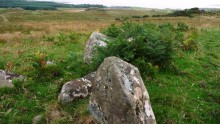|
|
|
|
BallynaughtonChambered Cairn
|
||||||||||||||||||||||||
|
|
|
Images (click to view fullsize) |
|









|
Fieldnotes |
|
|
After fair time at Druim Mor we kept heading north to head of the dyke, then headed west following a fence till it met a dyke which headed north. Follow this until it ends and keep heading north over slightly rougher ground. Look for a gap in hill in front, the chamber cairn is just to the west. One of several Clyde type chamber cairns, hardly any of the cairn material remains, presumably why there are dry stane dykes in the area. Better than me explaining I'll let Canmore explain : This cairn is situated 300m w of the ruins of Ballynaughton More on a relatively narrow strip of almost level rough grazing bounded by arable Fields to the SE and by a rocky ridge to the NW. Only a little cairn material remains, now almost completely overgrown, but as shown on the plan it appears to extend intermittently over an area measuring about 20m from NE to sw by a maximum of 10m transversely; whatever its precise size may originally have been, it seems likely that the cairn was trapezoidal in shape, with a breadth of not more than 16m at the broader (NE) end and a length of at least 20 m. Entered from the NE, the roofless chamber is about 6m long and up to l-5m wide internally, and is divided by transverse septal slabs into four compartments. Immediately N of the entrance there is a pointed stone, I m high above ground level, which may be one of a pair of portal stones; what appears to be its fallen partner would, if erect, occupy a corresponding position at the s side of the entrance. Most of the slabs forming the chamber are massive blocks, now- exposed up to 0-9 m above ground: during excavations carried out in 1901 ' it was found that the surviving side-slabs of the two outermost compartments were standing to a Ileight of as much as 1 -42 m above the floor. Although at least two side-slabs are missing, it can be seen that the chamber decreases in width towards the rear. from a maximum of about l-5m to 0-6 m at the back of the innermost compartment. Likewise the compartments contract both in length and height, and the innermost is evidently a less substantial structure than the others, only the tops of its stones being at present visible at turf level. The septal stones rise almost to the same height as the side-slabs they support and the disposition of the side-slabs shows the successive overlapping (or imbrication) characteristic of chambered cairns of Clyde type. The chamber contains a layer of debris about 0.6m deep, but when emptied in 1901 it was filled with stones and soil from which were recovered a chert flake and one tiny fragment of burnt bone; the discovery of a hoard of coins, dating from the mid-15th to mid-16th centuries AD, which lay hidden in the E corner of the third compartment, suggested to the excavator that the chamber had already been disturbed and rifled by the time the hoard was deposited. All the finds are lost. Now I liked this site, it has atmosphere with superb views to the south, east and west. Like a lot of these places it would worth a trip back in time to see what they really looked like. At least the chamber remains, after a good look round it was time to press on. Visited 3/8/2018. |
20th March 2019ce |

